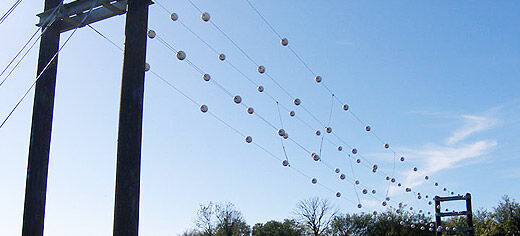
Wire bridges built to guide bats safely across busy roads simply do not work, University of Leeds researchers have confirmed.
In a study published today (13 June 2012) in PLoS ONE, a team from the University’s Faculty of Biological Sciences monitored four wire bridges spanning major roads in the north of England. All had been built over the last nine years to replace hedgerows – the bats’ established commuting routes – when these routes were severed by new roads.
Roads act as barriers to bats, cutting colonies off from established feeding sites and reducing their ability to feed themselves and their young 1. Most species of bat fly relatively close to the ground or close to trees and hedges, for protection against the weather and potential predators. Those that do cross roads typically do so at traffic height, with a high risk of collision – so the wire bridges are a common conservation measure aimed at encouraging bats to cross above the traffic.
Using bat detectors – which pick up the bats’ high frequency echolocation calls – and night video equipment, the team measured the height at which bats crossed the road and their proximity to the wire bridges and compared the results with bats crossing at nearby severed hedgerows without wire bridges.
The Leeds team showed that almost all the bats in the study favoured their former commuting routes rather than the wire bridges, crossing the road at a low height. There was no evidence to suggest that the bats changed their behaviour in response to the bridges, even over time. A well-established wire bridge built nine years ago and only 15 metres from the severed commuting route it replaced was still spurned by the bats.
Study leader, Professor John Altringham said: “The results of this research are relevant to small insectivorous bats worldwide and highlight the impact of roads on wildlife in general.”
Under UK and European law, governments have an obligation to ensure that development does not have a detrimental effect on populations of protected species. Wire bridges are assumed to act as artificial aerial hedges, guiding bats safely over traffic and are an increasingly favoured mitigation tool across Europe.
Referring to the costs associated with the installation of bat bridges 2, Professor Altringham says: “Conservation measures are sometimes widely implemented without evidence to support their effectiveness, and large sums of public money are being spent without any proven benefit to nature.”
The paper’s lead author, PhD student Anna Berthinussen, said: “Many bat species forage up to several kilometres from their roost, so our road system is an ever expanding network of life-threatening hurdles the bats must overcome. Our findings raise concerns about how we can build or improve roads without impacting on these protected species. “We need to find solutions that really work and suggest that alternative designs are investigated and, most importantly, tested more effectively than they have been in the past.”Ms Berthinussen has also been investigating the extent to which bats make use of underpasses built to carry roads and footpaths under roads. Of three underpasses studied, only one was used extensively by bats, but she believes there may be potential to improve their attractiveness to bats.
References
- In a previous study published in the Journal of Applied Ecology last year, the Leeds team showed that the number and diversity of bats can be significantly depleted near major roads. (doi: 10.1111/j.1365-2664.2011.02068.x)
- http://www.publications.parliament.uk/pa/ld201011/ldhansrd/text/111004w0001.htm
Further information from:
Professor Altringham is available for interview.
Contact: University of Leeds Communications & Press Office: Tel +44 (0)113 343 4031, email pressoffice@leeds.ac.uk
Notes to editors:
- The paper, titled Do bat gantries and underpasses help bats cross roads safely? is published on PLoS ONE on 13 June 2012 (http://dx.plos.org/10.1371/journal.pone.0038775). A copy of the paper is available from Campus PR.
- John Altringham is Professor of Animal Ecology and Conservation in the School of Biology at the University of Leeds. www.fbs.leeds.ac.uk/staff/profile.php?tag=Altringham
- The Faculty of Biological Sciences at the University of Leeds is one of the largest in the UK, with over 110 academic staff and over 400 postdoctoral fellows and postgraduate students. The Faculty is ranked 4th in the UK (Nature Journal, 457 (2009) doi:10.1038/457013a) based on results of the 2008 Research Assessment Exercise (RAE). The RAE feedback noted that “virtually all outputs were assessed as being recognized internationally, with many (60%) being internationally excellent or world-leading” in quality. The Faculty’s research grant portfolio totals some £53M and funders include charities, research councils, the European Union and industry. http://www.fbs.leeds.ac.uk/
- The 2008 Research Assessment Exercise showed the University of Leeds to be the UK's eighth biggest research powerhouse. The University is one of the largest higher education institutions in the UK and a member of the Russell Group of research-intensive universities. The University's vision is to secure a place among the world's top 50 by 2015.